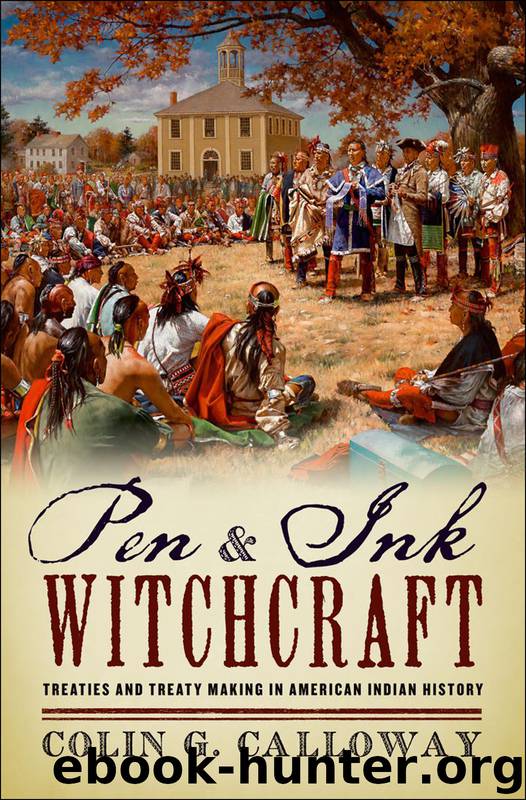Pen and Ink Witchcraft by Calloway Colin G

Author:Calloway, Colin G.
Language: eng
Format: epub
Publisher: Oxford University Press, USA
Published: 2013-01-28T16:00:00+00:00
FIGURE 6.2 George Bent and his Cheyenne wife, Magpie, 1867. Magpie gave birth to a daughter on the opening day of the Medicine Lodge council. (Courtesy of History Colorado, Scan #10025735)
The commissioners arrived at Fort Larned, eighty miles northeast of Medicine Lodge, on October 12. There they were met by several chiefs whom Murphy had asked to escort them to the council site: the Crow, Stumbling Bear, and Satanta of the Kiowas, and Little Raven, Yellow Bear, and Wolf Slave of the Arapahos.
FIGURE 6.3 Satanta. Photograph by W. S. Soule c. 1867. (Smithsonian Institution, National Anthropological Archives and Human Studies Film Archives)
Satanta, or White Bear (figure 6.3) was a member of an elite warrior society known as the Koietsenko, Katsienko, or Qóichégàu (“the Real/Principal Dogs” or “Sentinel Horses”); as one of only ten sash wearers in the society, he was considered one of the Kiowas’ “greatest and bravest warriors.”22 Contemporaries described him as “a man of magnificent physique, being over six feet tall, well built and finely proportioned.” He also had a reputation for oratory and theatrics, arrogance and boastfulness, characteristics he displayed at Medicine Lodge.23 He had built a record and a reputation as a fierce raider. On one occasion, after driving off horses from Fort Larned, Satanta sent a message to the post commander, complaining about the quality of the horses and expressing his hope that the army would provide better animals for him to steal in the future. On another, dressed in clothes he had been given at a council, he led a raid that stampeded the herd at Fort Dodge. “He had the politeness, however, to raise his plumed hat to the garrison of the fort, though he discourteously shook his coattails at them as he rode away with the captured stock.”24 He was about fifty years old in 1867. His face was painted red, he wore a blanket, and he carried a brass bugle hanging from his waist. He had met Henry Stanley the year before and now greeted him with “a gigantic bear’s hug.” The other members of the press “looked upon him with some awe, having heard so much of his ferocity and boldness. By his defiant and independent bearing he attracted all eyes.” Stanley felt “he would certainly be a formidable enemy to encounter alone on the prairie.” Satanta boasted that he had killed more white men than any other Indian on the Plains.25 He had also declared that he wanted all military posts and troops removed from his country immediately.26
The reporter William Fayel was impressed with Satanta’s “splendid physique” and with his reputation as a terror to frontier whites. He noted: “His head is large and massive, measuring twenty-three inches around the cranium only one inch less than that of Daniel Webster.” Another correspondent reckoned the crania of Satanta and Webster were of equal size. The scenario of newspaper correspondents sitting down the infamous warrior and measuring his head is certainly bizarre, but as the historian Charles Robinson notes, it is
Download
This site does not store any files on its server. We only index and link to content provided by other sites. Please contact the content providers to delete copyright contents if any and email us, we'll remove relevant links or contents immediately.
| African Americans | Civil War |
| Colonial Period | Immigrants |
| Revolution & Founding | State & Local |
Cat's cradle by Kurt Vonnegut(15185)
Pimp by Iceberg Slim(14394)
4 3 2 1: A Novel by Paul Auster(12284)
Underground: A Human History of the Worlds Beneath Our Feet by Will Hunt(12024)
The Radium Girls by Kate Moore(11921)
Wiseguy by Nicholas Pileggi(5671)
Perfect Rhythm by Jae(5324)
American History Stories, Volume III (Yesterday's Classics) by Pratt Mara L(5256)
The Fire Next Time by James Baldwin(5249)
Paper Towns by Green John(5089)
Pale Blue Dot by Carl Sagan(4912)
A Higher Loyalty: Truth, Lies, and Leadership by James Comey(4845)
The Mayflower and the Pilgrims' New World by Nathaniel Philbrick(4423)
The Doomsday Machine by Daniel Ellsberg(4416)
Killers of the Flower Moon: The Osage Murders and the Birth of the FBI by David Grann(4386)
The Sympathizer by Viet Thanh Nguyen(4305)
Too Much and Not the Mood by Durga Chew-Bose(4273)
The Borden Murders by Sarah Miller(4247)
Sticky Fingers by Joe Hagan(4101)
